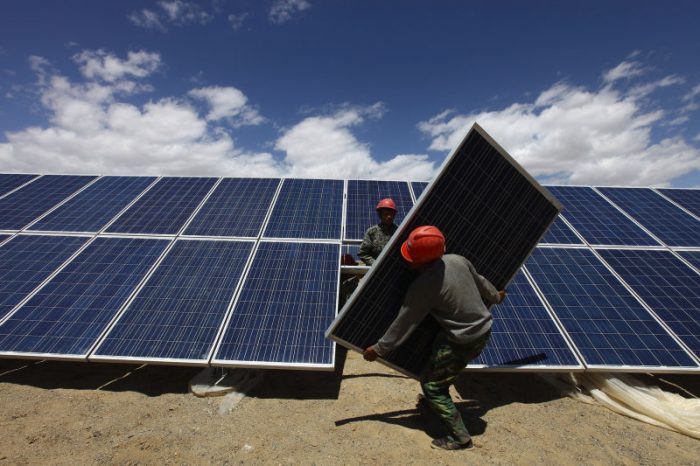Leading economists and energy experts have called on governments to use public investment and regulatory controls to rapidly scale up the transition to clean energy and bring down costs while achieving global climate goals.
A new report launched on Thursday, based on a comprehensive analysis of global energy policy over the last three decades, says that as well as replicating the outstanding successes of the energy transition so far – such as offshore wind and solar PV, governments must go beyond providing a level playing field.
It says they should instead proactively use all three policy levers – investment, tax and regulation – to accelerate innovation and reduce the cost of clean technologies, and recommends that they target ‘tipping points’, where clean technologies gain an advantage over fossil fuels to secure a rapid reallocation of investment.
The report, titled ‘Ten Principles for Policymaking in the Energy Transition: Lessons From Experience’, says the successes of onshore wind, offshore wind, solar PV and electric vehicles were driven by governments that identified and support the technologies they needed to succeed.
It calls for governments to urgently reshape their policy approaches to accelerate innovation, job-creation and cost reduction in the transition to clean energy.
‘Decisive Government Action is Essential’
The findings are consistent with a report by the International Energy Agency, the International Renewable Energy Agency and the UNFCCC Climate Champions on ways to get faster progress toward global climate goals by coordinating action on emitting sectors, focusing on tipping points so clean tech becomes the most affordable, accessible and attractive options.
One of the lead authors of the report, Laura Diaz Anadon, a professor of climate change policy and director of Cambridge University’s Centre for Environment, Energy and Natural Resource Governance, said: “Decisive government action is essential, but to succeed it must rely on a different set of policy principles, given the transformational scale of change required.
“Governments cannot simply set the goal and encourage the market to deliver,” Anadon said. “They must be active participants – investing to de-risk markets, regulating to bring down costs, and making strategic technology choices to incentivise and focus the private sector. Doing so can deliver a transition to clean energy that is faster, cheaper and more sustainable for all.”
Investment into clean energy sectors, including power generation, electricity grids, road transport, steelmaking and hydrogen, could support 65 million jobs and $26 trillion of benefits by 2030, the report says.
The report comes from the Economics of Energy Innovation and System Transition (EEIST) project, which is a partnership between leading world research institutions in the UK, EU, Brazil, China and India. This was funded by the UK government and the Children’s Investment Fund Foundation.
ALSO SEE: Flood-Hit Pakistan Should Seek Loan Rejig, UN Says – FT
Targeted Support
It details how targeted support for key technologies, such as wind and solar, energy storage and LED lighting, which the economic analysis initially did not recommend, radically ramped up innovation, cost reductions and economic growth, far beyond technology-neutral policies.
Solar PV, for example, was initially criticised by economists due to its high cost per unit of energy. But, as Germany, China and other countries applied subsidies and other policies to incentivise deployment, the costs fell by a factor of 10,000, helping solar PV to become the world’s cheapest source of electricity in history.
These advocates lauded the Biden Administration’s Inflation Reduction Act as clear and deliberation state intervention to bring down the cost of clean technologies, by creating a ‘demand pull’ from combined fiscal incentives and regulations. Their report details 10 principles for policymakers.
Ten Principles for Policymakers
These principles provide a playbook for governments to shape the policies needed to rapidly scale the technologies needed to decarbonise energy and grow economic prosperity worldwide.
- Target specific technologies: Targeting support to specific technologies can drive faster adoption and greater cost reduction than technology-neutral policies.
- Invest and regulate: Government investment and regulation can bring down the cost of clean technologies by sending clear signals to the market and increasing demand.
- De-risk markets: Targeted government action to reduce the risk of private investment in clean technologies can greatly increase rates of investment and deployment, compared to the market alone.
- Target tipping points: Pricing carbon alone is insufficient to achieve the energy transition – targeting tipping points when designing regulation or fiscal incentives can help to drive faster progress.
- Be adaptive: It is impossible to predict the ‘best’ way to achieve a low carbon transition –policy should learn from doing and adapt to unforeseen changes.
- Combine policies: Implement mutually reinforcing policies to deliver greater impact that is more than the sum of their parts.
- Ensure a just transition: A ‘just transition’ should be central to policy choices to ensure fairness and social support for the low carbon transition.
- Grow global markets: International efforts should not be limited to growing carbon markets – growing global markets for clean technologies drives faster and more affordable energy transitions.
- Consider opportunities and risks: Policy appraisal should look beyond costs and benefits and consider wider risks and opportunities to better assess policy outcomes.
- Understand bias: There are no ‘correct’ answers in policy analysis – policy makers must be aware of their biases and use a range of models to make transparent and robust choices.
New approaches to policymaking are seen as essential to achieve the goals of the Breakthrough Agenda, the international plan supported by 45 countries to target tipping points in key clean energy technologies by 2030.
- By Jim Pollard
ALSO SEE:
World’s Shift to 100% Clean Energy Paid in 6 Years: Stanford
US, IEA Ask Asia to Cut Reliance on China, Russia For Energy
China Reaffirms Green Energy Promises as Coal Stocks Soar
Covid, Supply Delays Hit New Energy Transition, Says Report






















